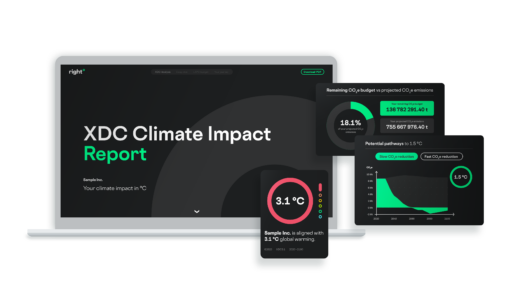XDC Climate Impact Report
Get an in-depth analysis of your current climate impact – now including calculation of your remaining emissions for becoming 1.5°C-aligned plus suggested pathways for achieving this target.
10.08.2023
Reference
The Provinzial Group used the XDC Model from right° to make sustainable hardware investment choices − with the °C metric as a decisive procurement criterion.
The catastrophic flooding in the Ahr Valley caused by storm “Bernd” in 2021 left insurer Provinzial Group in no doubt: Resolute climate action was urgently needed to protect against increasingly frequent natural risks and disasters. Provinzial had already set ambitious in-house climate targets, and its workforce is committed to the decarbonisation of all relevant processes across the Group. So when the time came to order new notebooks, Sustainability Officer Astrid Bayer and Project Manager Maike Augstein and their team were determined to find a sustainable solution – not least as a means of further reducing Provinzial’s upstream Scope 3 emissions.
“Scope 3 offers the greatest leverage for mitigating our company’s climate impact, so choosing which manufacturer to buy from is a key consideration.”
Astrid Bayer, Sustainability Officer, Provinzial Group
A successful strategy for sustainable procurement
Every purchase decision supports or undermines progress towards a 1.5°C planet, so there’s a lot at stake. But well-informed purchase recommendations need to be based on robust sustainability comparisons between manufacturers and their products. Is that a realistic proposition? As the team led by Astrid Bayer and Maike Augstein soon realised, the environmental awards, seals and carbon emission data of different products and manufacturers are virtually impossible to compare. They faced the same problem trying to compare the climate goals indicated in the sustainability reports of the shortlisted suppliers. There was no clear, comparable metric on which to base a well-founded assessment. And there was no transparency about how far the climate goals cited would actually contribute to a 1.5°C planet.
Frustrated by these unanswered questions, the project team set about finding an alternative approach. Might the X-Degree Compatibility (XDC) Model already being used elsewhere in the company serve up the urgently required data with which to compare suppliers? Astrid Bayer and Maike Augstein saw the potential here and worked closely with right° to analyse the climate impact of the hardware manufacturers. The outcome was a straightforward and above all comparable °C metric, showing the project team the impact of each company’s commercial activities on global warming. Subsequent calculations using the XDC Scenario Explorer from right° also took account of future climate goals to Illustrate each manufacturer’s temperature trajectory. Breaking new ground here, Provinzial were the first to employ the XDC Model in their procurement process. The metric allowed them to compare manufacturers according to specific climate criteria and arrive at a science-based purchase recommendation.
“A metric that expresses climate impact in °C gives us the comparable criterion we need for our procurement process. When we saw abstract emission data suddenly translated into an actual number, we knew it was a game-changer.”
Maike Augstein, Project Manager, Provinzial Group
A project with major implications for the whole Group
Moving forward, who will want to buy from a 3°C company? Provinzial’s sustainable hardware procurement process makes this question more relevant than ever. The project team was able to establish climate impact as a new requirement to be factored in alongside quality, budget, and lead times when selecting suppliers. The °C metric proved an effective and robust criterion for assessing environmental sustainability. Its simplicity and clarity were perfect for explaining the rationale behind purchase decisions to the entire workforce, not just the project team. In addition, calculations based on the XDC Model also helped to create an awareness within the Group of the major impact that purchase decisions have on Scope 3 emissions.
Provinzial was already using the XDC Model to analyse the Group’s own climate impact and monitor the Paris-alignment of its investment portfolio. By applying it to the hardware procurement process, the metric has now been extended to project management as well. The °C indicator provides the insurer with a uniform and easily understood point of reference that can be applied across multiple segments. This is key, because climate
transition demands a huge, concerted effort which will only succeed if each and every employee across the Group plays their part.
“The °C metric delivers clear guidance and focuses everyone’s attention on the 1.5°C goal. It provides a tangible, direct measurement of a company’s climate performance.
Astrid Bayer, Sustainability Officer, Provinzial Group

Get an in-depth analysis of your current climate impact – now including calculation of your remaining emissions for becoming 1.5°C-aligned plus suggested pathways for achieving this target.